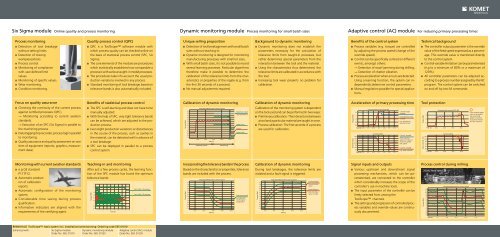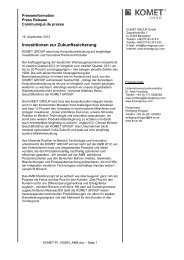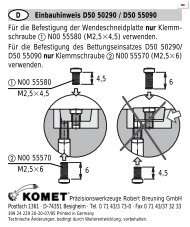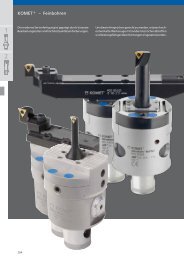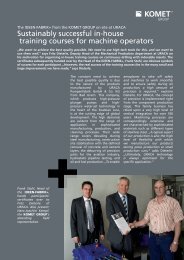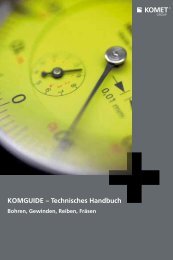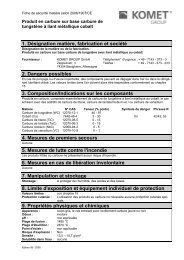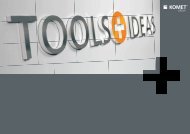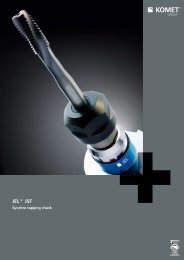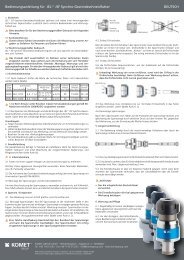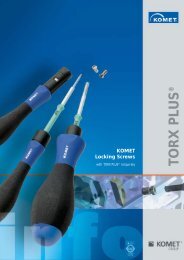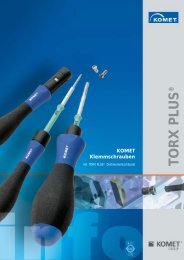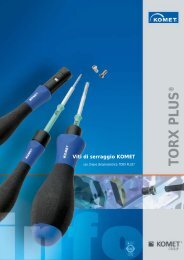Modules BRINKHAUS ToolScope - komet group
Modules BRINKHAUS ToolScope - komet group
Modules BRINKHAUS ToolScope - komet group
You also want an ePaper? Increase the reach of your titles
YUMPU automatically turns print PDFs into web optimized ePapers that Google loves.
Six Sigma module Online quality and process monitoring Dynamic monitoring module Process monitoring for small batch sizes<br />
Process monitoring<br />
Detection of tool breakage<br />
without setting limits.<br />
Detection of missing<br />
workpieces/tools.<br />
Process control.<br />
Monitoring of compliance<br />
with user-defined limit<br />
values.<br />
Monitoring of specific values.<br />
Wear monitoring.<br />
Condition monitoring.<br />
Focus on quality assurance<br />
Checking the continuity of the current process<br />
against certified processes (QPC).<br />
R Monitoring according to current aviation<br />
standards.<br />
R Execution of an SPC (Six Sigma) in parallel to<br />
the machining process.<br />
Data logging (trip recorder, process log) in parallel<br />
to monitoring.<br />
Quality assurance and quality assessment on one<br />
item of equipment (reports, graphics, measurement<br />
data).<br />
Monitoring with current aviation standards<br />
e.g GE standard<br />
P11TF12.<br />
Automatic production<br />
of calibration<br />
reports.<br />
Automatic configuration of the monitoring<br />
system.<br />
Considerable time saving during process<br />
qualification.<br />
Informative indicators are aligned with the<br />
requirements of the certifying agent.<br />
Quality process control (QPC)<br />
QPC is a <strong>ToolScope</strong> software module with<br />
which process quality can be checked online on<br />
the basis of statistical process control (SPC, Six<br />
Sigma).<br />
The core elements of the module are procedures<br />
which statistically establishes how comparable a<br />
process is with various taught-in model processes.<br />
The procedures take info account the usual production<br />
variations involved in any process.<br />
Standard monitoring of tool breakage based on<br />
tolerance bands is also automatically included.<br />
Benefits of statistical process control<br />
The SPC is self-learning and does not have to be<br />
manually adjusted.<br />
With the help of SPC, very tight tolerance bands<br />
can be achieved, which are adjusted to the production<br />
process.<br />
Even slight production variations or disturbances<br />
in the course of the process, such as cavities in<br />
the material, can be detected well in advance of<br />
a tool breakage.<br />
SPC can be deployed in parallel to a process<br />
control system.<br />
Teaching-in and monitoring<br />
After just a few process cycles, the learning function<br />
of the SPC module has found the optimum<br />
tolerance bands.<br />
1,4<br />
1,2<br />
1<br />
0,8<br />
0,6<br />
0,4<br />
0,2<br />
0<br />
-0,2<br />
-0,4<br />
1 2 3 4 5 6 7 8 9<br />
Time (s)<br />
<strong>BRINKHAUS</strong> <strong>ToolScope</strong> basic system incl. installation/commissioning: Ordering code E65 01010<br />
Enhanced with: Six Sigma module<br />
Order No. E65 21010<br />
Torque (Nm)<br />
Dynamic monitoring module<br />
Order No. E65 21020<br />
Limit after 1st process<br />
Limit after 7th process<br />
Adaptive control (AC) module<br />
Order No. E65 21030<br />
Unique selling proposition<br />
Detection of tool breakage even with small batch<br />
sizes without teaching-in.<br />
Dynamic monitoring is designed for monitoring<br />
manufacturing processes with small lot sizes.<br />
With small batch sizes, it is not possible to record<br />
several learning processes. Particular algorithms<br />
therefore make it possible to determine the<br />
calibration of the tolerance limits from the characteristics<br />
or properties of the ingate (e.g. from<br />
the first 30 seconds of a process).<br />
No manual adjustments required.<br />
Calibration of dynamic monitoring<br />
Torque (Nm)<br />
5,5<br />
5,0<br />
4,5<br />
4,0<br />
3,5<br />
3,0<br />
2,5<br />
2,0<br />
1,5<br />
1,0<br />
0,5<br />
0,0<br />
-0,5<br />
-1,0<br />
5,5<br />
5,0<br />
4,5<br />
4,0<br />
3,5<br />
3,0<br />
2,5<br />
2,0<br />
1,5<br />
1,0<br />
0,5<br />
0,0<br />
-0,5<br />
-1,0<br />
....................................................<br />
10,0 20,0 30,0<br />
Time (s)<br />
40,0<br />
Incorporating the tolerance bands in the process<br />
Based on the characteristics or properties, tolerance<br />
bands are included with the process.<br />
Torque (Nm)<br />
Torque/spindle/machine control system<br />
Calibration phase Monitoring<br />
Torque/spindle/machine control system<br />
51,0 52,0 53,0<br />
Time (s)<br />
54,0<br />
50,0<br />
55,0<br />
Maximum value<br />
(tool protection)<br />
Upper limit<br />
Signal<br />
Lower limit<br />
Tolerance bands<br />
are adjusted<br />
to the signal<br />
progression<br />
Background to dynamic monitoring<br />
Dynamic monitoring does not establish the<br />
parameters necessary for the calculation of<br />
tolerance limits from taught-in processes, but<br />
rather determines special parameters from the<br />
interaction between the tool and the material.<br />
Using the characteristics thus determined, the<br />
tolerance limits are calibrated in accordance with<br />
the tool.<br />
Increasing tool wear presents no problem for<br />
calibration.<br />
Calibration of dynamic monitoring<br />
Calibration of the monitoring system is dependent<br />
on the tool used and can be performed in two ways:<br />
Preliminary calibration: The interactions between<br />
a tool and a particular material are taught in once.<br />
Process calibration: The first seconds of a process<br />
are used for calibration.<br />
Calibration of dynamic monitoring<br />
During tool breakages, the tolerance limits are<br />
violated and a fault signal is triggered.<br />
Torque (Nm)<br />
5,5<br />
5,0<br />
4,5<br />
4,0<br />
3,5<br />
3,0<br />
2,5<br />
2,0<br />
1,5<br />
1,0<br />
0,5<br />
0,0<br />
-0,5<br />
-1,0<br />
Torque/spindle/machine control system<br />
7,0 8,0 9,0<br />
Time (s)<br />
10,0<br />
11,0<br />
Tool breakage<br />
Torque breaks<br />
down<br />
Signal departs<br />
from the tolerance<br />
corridor<br />
Adaptive control (AC) module For reducing primary processing times<br />
Benefits of the control system<br />
Process variables (e.g. torque) are controlled<br />
by adjusting the process speed (change of the<br />
override speed).<br />
Control can be specifically centred on different<br />
events, amongst others:<br />
R Detection of swarf jamming during drilling,<br />
R Detection of chatter vibration.<br />
Process acceleration when air cuts are detected.<br />
Using a learning function, the system can independently<br />
determine control parameters.<br />
Manual regulation possible for special applications.<br />
Acceleration of primary processing time<br />
Torque (Nm)<br />
Override value<br />
1,2<br />
1,1<br />
1,0<br />
0,9<br />
0,8<br />
Torque/spindle revolver/CTX-420<br />
Time (s) 0,25 0,5 0,75 1,0 1,25 1,5 1,75<br />
Control system<br />
130,0<br />
120,0<br />
110,0<br />
100,0<br />
90,0<br />
80,0<br />
70,0<br />
Time (s) 0,25 0,5 0,75 1,0 1,25 1,5 1,75<br />
Signal inputs and outputs<br />
Control target<br />
variable<br />
Controlled process<br />
variable<br />
e.g. machining<br />
spindle torque<br />
Control variable<br />
shifts into the<br />
upper limit due to<br />
machine spindle<br />
idle speed<br />
Control variable<br />
e.g. feed override<br />
Various upstream and downstream signal<br />
processing mechanisms, which can be parameterised,<br />
are connected to the controller<br />
which considerably increases the scope of the<br />
controller's use in machine tools.<br />
The input parameter of the controller can be<br />
freely selected from among the<br />
<strong>ToolScope</strong> channels.<br />
The settings and progression of controlled process<br />
variables and override values are continuously<br />
documented.<br />
Technical background<br />
The controller output parameter is the override<br />
value of the feed speed expressed as a percentage.<br />
This override value is transferred directly<br />
to the control system.<br />
Control variable limitation can be parameterised<br />
(e.g to a minimum of 80% or a maximum of<br />
120%).<br />
All controller parameters can be adjusted according<br />
to a process number assigned by the NC<br />
program. The control system can be switched<br />
on and off by two M commands.<br />
Tool protection<br />
Torque (Nm)<br />
Track override (%)<br />
3,0<br />
2,0<br />
1,0<br />
Time (s)<br />
105,0<br />
100,0<br />
95,0<br />
90,0<br />
85,0<br />
80,0<br />
Time (s)<br />
12,0<br />
11,0<br />
10,0<br />
9,0<br />
8,0<br />
7,0<br />
6,0<br />
5,0<br />
4,0<br />
3,0<br />
2,0<br />
1,0<br />
0,0<br />
-1,0<br />
-2,0<br />
-3,0<br />
-4,0<br />
Time (s)<br />
Torque/spindle revolver/CTX-420<br />
10,0 20,0 30,0 40,0<br />
Control system<br />
10,0 20,0 30,0 40,0<br />
Process control during milling<br />
Torque (Nm)<br />
200% feed rate<br />
Torque/spindle/machine control system<br />
7,0 8,0 9,0 10,0<br />
If the torque target<br />
value is exceeded,<br />
the machining<br />
speed is reduced<br />
to protect the tool<br />
and the machine<br />
11,0
Storage oscilloscope and data logger for machine tools<br />
Quality assessment of the production process<br />
Saving of internal and external<br />
machine sensor data as a<br />
process log.<br />
Quality verification easily accomplished<br />
through automatic<br />
creation of reports (e.g. pdf).<br />
Complete process transparency.<br />
Review of faults that have occurred in previous<br />
months.<br />
Process data is processed and visualised in the<br />
form of physical values.<br />
Storage oscilloscope for machine tools<br />
Torque (Nm)<br />
4,5<br />
4,0<br />
3,5<br />
3,0<br />
2,5<br />
2,0<br />
1,5<br />
1,0<br />
0,5<br />
100,0 125,0<br />
Time (s)<br />
150,0<br />
Feed rate force<br />
0,8<br />
0,7<br />
0,6<br />
0,5<br />
0,4<br />
0,3<br />
0,2<br />
0,1<br />
0,0<br />
-0,1<br />
-0,2<br />
-0,3<br />
-0,4<br />
21,0 22,0 23,0<br />
Time (s)<br />
24,0 25,0<br />
175,0<br />
View process sequences easily online<br />
Feed rate force<br />
Channel 1: Torque/spindle/Chiron FZ 15S<br />
Irregularities are<br />
immediately visible<br />
Upper<br />
alarm limit<br />
Sensor signal<br />
Lower<br />
alarm limit<br />
Unique selling proposition as data logger<br />
In contrast to software solutions:<br />
R No adverse effect on the<br />
machine,<br />
R Real-time data acquisition<br />
with inclusion of analogue sensors.<br />
Can be expanded with any monitoring functions<br />
through software licence upgrades.<br />
Fileable process documentation, e.g pdf.<br />
Memory capacity 1-10 months, depending on<br />
sensor data rate.<br />
Data logger benefits<br />
Fault-free running of individual process steps can<br />
be verified on the basis of the signal progressions.<br />
Faults such as swarf jams in a drilled hole (see<br />
picture on left) can be quickly identified.<br />
Potential for optimisations in the NC program can<br />
be discovered (reduction in primary processing<br />
time) through analysing the signal progressions.<br />
Rapid qualification of new tools, e.g. optimum<br />
cutting edge geometry.<br />
Saving of process data in an Excel readable format<br />
(process log).<br />
Wide range of system usage<br />
In addition to standard machining processes such as<br />
turning, milling, drilling, etc., the system can also be<br />
used in many other processes, e.g. reaming, grinding<br />
and punching.<br />
Supported types of control system: Siemens 840D SL, 840D PL, Haidenhein, Fanuc, Beckhoff, from year of<br />
manufacture 2000 applies for all control systems. Other types and years of manufacture possible on request.<br />
Integration of the system into the machine tool<br />
Technical data<br />
System structure<br />
Control panel<br />
visualisation<br />
<strong>ToolScope</strong><br />
External sensors<br />
for motor output,<br />
structure-borne<br />
sound, acceleration<br />
Alarm messages<br />
Internal machine sensors (torques, etc.)<br />
Sensors and data transfer rates<br />
“Sensorless measuring”<br />
Reading out of internal machine sensors digitally,<br />
directly from the control system (with approx. 100Hz)<br />
R Torque<br />
R Feed rate speed<br />
R Motor current<br />
R Workpiece number, tool number, etc.<br />
External sensors: Recording of any analogue signals<br />
from -10V to 10V (up to 10kHz)<br />
R Structure-borne sound, acceleration, etc.<br />
R Sensor data of analogue controlled drives.<br />
Support and updates<br />
Installation and commissioning takes approx. 1-2<br />
days and is carried out by one of our technicians<br />
(machine downtime 3-6 hours).<br />
Service and support for machine operators is very important<br />
to us. We provide assistance, for example, during the<br />
operation or adjustment of new monitoring strategies,<br />
whether by telephone, remote connection or on site.<br />
The system is under constant further development<br />
so that in future you will still be able to benefit from<br />
new monitoring strategies, adjustment options and<br />
other innovations.<br />
Machine<br />
Siemens<br />
Rectifier/intermediate<br />
circuit<br />
NCU<br />
Axis controller<br />
Integration into the control system<br />
Capture of internal sensor data via Profibus (integration<br />
in the compile cycle). External sensors are<br />
recorded by means of an A/D converter.<br />
Monitoring is started and stopped directly from the<br />
NC program. Either automatically during each G0/<br />
G1 change or manually via M commands.<br />
User information can be transferred to the monitoring<br />
system.<br />
Complete system operability via the operatormachine<br />
interface (HMI) or via touchscreen.<br />
Report log readout via USB, network reports.<br />
Receptiveness for user projects<br />
Real-time transfer of recorded measurement data<br />
to user applications (measurement data server).<br />
Transfer of commands from user applications to<br />
the machine tool.<br />
Data access possible via LabVIEW, Matlab, C++,<br />
Java, C#, amongst others.<br />
Can also work with Windows XP for development<br />
and evaluation purposes.<br />
Office-suitable data export.<br />
Our service: Design, implementation and field test<br />
of any kind of monitoring and control strategies<br />
according to customer requirements.<br />
Customer-specific modules<br />
We would be pleased to provide you with support<br />
in the development of customer-specific monitoring<br />
modules for your particular machining process.<br />
Connection to MDE/BDE- systems.<br />
Condition monitoring module.<br />
Generation of automatic shift logs.<br />
Visualisation of the productivity of all machines over<br />
a period of time. Listing of machine times: Machine<br />
productivity, readiness, failure, etc.<br />
KOMET <strong>BRINKHAUS</strong> GmbH · Heidehaus – Haus 8 · Am Leineufer 70 · 30419 Hannover · GERMANY<br />
Tel. +49 511 7636310 · Fax +49 511 76363190 · info.brinkhaus@<strong>komet</strong><strong>group</strong>.com · www.<strong>komet</strong><strong>group</strong>.com/brinkhaus<br />
399 01 805 01-1T-08/12 Printed in Germany · © 2012 KOMET GROUP GmbH · We reserve the right to make modifications.<br />
Axis controller<br />
Torque<br />
Channal 1: Torque / Spindle / Chrion FZ 15S<br />
Visualisation Monitoring Optimisation<br />
Documentation<br />
<strong>BRINKHAUS</strong> <strong>ToolScope</strong><br />
Process monitoring – the benefit for your production<br />
BENEFITS for you:<br />
Torque<br />
Chipping<br />
impedes production<br />
Time (s)<br />
Time (s)<br />
Torque/spindle/machine control system<br />
Feed force (kN)<br />
Global presence with 20 subsidiaries, 50 international<br />
branches on all five continents, and 40 Service and Sales<br />
centres with around 1700 employees guarantee service<br />
to the customer<br />
Storage oscilloscope and data logger for machine tools<br />
with automatic documentation<br />
Process monitoring with tolerance bands<br />
Process monitoring by means of statistical process control<br />
Self-learning tolerance limits<br />
Property-based monitoring algorithms for small-batch<br />
production (dynamic monitoring)<br />
Average feed force<br />
Number of processes<br />
Tool wear monitoring<br />
Process control and optimisation of machining<br />
time (also in parallel to monitoring)<br />
Simple integration into the control system<br />
Measuring without sensors but inclusion of<br />
external sensors possible<br />
Operation via HMI, network, remote control<br />
Reduction of rejects, rework, secondary damage<br />
Higher level of productivity, process reliability<br />
and machine availability


